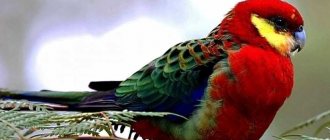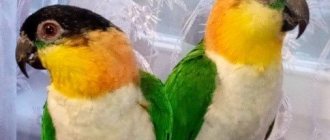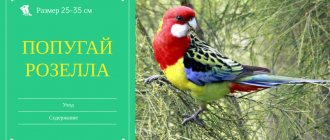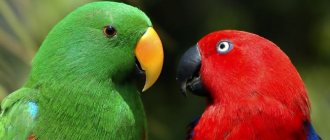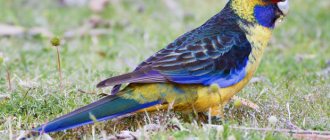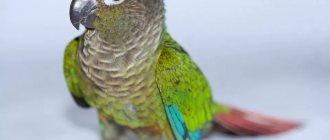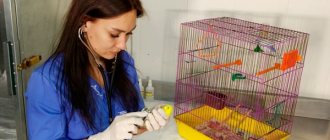Appearance and description
The Rosella parrot has been known for over 200 years. And although its natural habitat is Australia, it can also live in Europe. Rosella is not a large species.
The average weight of a parrot is 50-60 g with a body length of 30-35 cm.
Ideally, the bird's appearance should correspond to the following description:
- The eyes are dark brown.
- The beak has a small, barely noticeable notch.
- The wings are no more than 10 cm long. In most varieties they are colored blue with black spots.
- Feathers are scaly. The center of each “scale” is black, and the edges are bright.
- The tail is wide, 14-17 cm long. There are 4 identical feathers in the center. The length of the side feathers decreases evenly, like a cascade.
Depending on the color, there are 7 varieties of rosella:
- Green rosellas. These parrots have blue cheeks and a red forehead. The back and shoulders of the birds are gray-green or yellow-green. The wings are green or charcoal with blue tips.
- Pale-headed rosellas. The back and shoulders of the birds are yellow with black spots. The head is painted a pale lemon color. The belly and chest are blue, the wings and tail are black and blue. There is a red spot on the back surface of the tail.
- Black-headed rosellas. The head and upper neck are black, the cheeks are white. The back is charcoal with pale yellow. The tail is blue-black with a red undertail. The chest is light yellow.
- Yellow-cheeked rosellas. The wings of these birds are colored yellow, green, blue and black. The undertail, chest, neck and head are red. Cheeks are yellow.
- Red rosellas. The wings of parrots are dominated by black plumage interspersed with rich blue. The rest of the body, with the exception of the tail and cheeks, is red.
- Variegated rosellas. The wings are bluish-purple with black spots inside. The abdomen and rump are light green. The neck is bright red.
- Ruby rosellas. The birds' body is covered with rich red plumage. The tail, cheeks and part of the wings are snow-white. The back and the rest of the wings are yellow.
Life in natural conditions
In almost every corner of Australia and on the surrounding islands, some variety of Rosella parrots is found. They prefer to inhabit gardens and forested areas near water sources. They don’t particularly like to move on the ground or trees, but they fly well.
The birds are not shy, they have adapted well to urban conditions, and therefore roam freely in parks and farmlands. Rosellas do not really like too humid and hot climates; a comfortable temperature for them is +20°C. Although they can exist quite well at -10°C.
Interesting! Despite their ability to destroy cultivated crops, these birds are not destroyed by people, since their benefits are great: they eat harmful insects and weeds.
Favorite food of rosellas: fruits, berries, insects and their larvae, plant seeds (acacia, wheat, clover, alfalfa) and grains.
Reproduction
The birds nest in hollow trees, although they are capable of occupying an empty rabbit or bee-eater hole located in steep clay banks. They may also make a nest on a pole or fence.
Rosella parrots become ready to reproduce at approximately one and a half years of age.
The process of a male courting a female is interesting: he proudly walks around - dancing around his partner, raising his feathers and fluffing his tail. The female reacts to courtship in the following way: having assumed the position of a chick, she begins to creak, as if begging for food. The male stops dancing and feeds the female. Similar advances are made several times.
Depending on the variety of rosella, a clutch may contain either three or nine eggs. Incubation takes 22-24 days. The female incubates the offspring, and the male searches for food.
Chicks are born blind, but not naked - in a light fluff. They begin to see from the tenth day. At 30 days they are already fully fledged and making attempts to fly out of the nest. The parents still feed the chicks for a couple of weeks.
The lifespan of Rosella parrots is 20-35 years.
Character and behavior
Rosellas are cheerful, sociable and intellectually developed parrots, capable of imitating the voices of other birds and the sounds of nature. They very quickly become attached to their owners and strive in every possible way to earn praise. Birds have a ringing, melodic and gentle voice. Their whistling singing is very similar to the sounds of a flute.
Parrots can chew things and disturb the silence with loud noises.
On a note. Rosellas have a weak ability to reproduce human speech. But with regular practice, they can remember up to 10 words.
Rosellas do not tolerate competition and do not get along with other birds. Therefore, it is advisable to keep them alone.
Where to buy and how much it costs
The average cost of a Rosella parrot in Russia is 7,000 rubles. The more exotic and beautiful the color of the bird, the more expensive the purchase will be. In addition, the price is affected by the place of sale:
- The most expensive parrots are those raised from nurseries.
- The price of birds sold in retail outlets (pet stores, markets) is based on the seller’s expenses.
- In private advertisements, breeders focus on demand and set the price tag taking into account the preferences of buyers.
Where can I buy a Rosella parrot, a rather rare bird? If you live in a small town, you should look for birds in a nearby large city. You can go to the nursery’s website to order delivery of a chick of a certain color.
Unusual color, pleasant voice, delicate behavior, calming calm - all this is about the Rosella parrot. The friendly but shy bird is not so often found in captivity, and this is due to difficulties in taming. For these birds, communication with other birds is more important than with humans.
Health and life expectancy in captivity
At home, rosellas live up to 25 years. But in the absence of proper care and proper living conditions, parrots begin to get sick.
These birds are predisposed to the following pathologies:
- goiter inflammation;
- aspergillotoxicosis;
- tuberculosis;
- psittacosis;
- mycoplasmosis;
- pasteurellosis;
- smallpox
Most often, health problems in rosellas begin due to vitamin deficiency, lack of microelements, violation of hygiene rules, untimely disinfection and improper living conditions (excessively humidified or dry air, drafts and low temperatures).
Important! Tuberculosis and psittacosis are transmitted from parrots to humans. If the bird has become apathetic, does not peck at food, does not drink, closes its eyes, often trembles all over its body, is tufted and does not take care of its plumage, it means that it is sick and should be immediately shown to a specialist.
Diseases and prevention
Under good conditions, many parrots of this species can live up to 35 years. Their life expectancy can be shortened by unbalanced nutrition, improper care and illness. What can rosella hurt:
- intestinal diseases (parasitic infestations, salmonellosis),
- mycoplasmosis,
- tuberculosis,
- goiter inflammation,
- smallpox,
- ornithosis,
- aspergillotoxicosis,
- pasteurellosis.
If you bought a new bird, do not rush to join it with other birds. You need to endure an adaptation period - quarantine - for two weeks .
Monitor your pet's condition so that you can notice the disease in time and contact a veterinarian. Symptoms of diseases in these parrots:
- the bird does not eat or drink or, on the contrary, drinks a lot,
- he closes his eyes all the time,
- sits ruffled in one place,
- may tremble
- does not clean feathers and does not bathe.
Keeping rosella at home
These Australian birds require full care and maintenance. At home, the Rosella parrot is placed in a warm, moderately lit and regularly ventilated room. The air temperature in the room where the poultry is kept should be between 20-22 degrees with a humidity of 50-60%.
Important! Rosella should be able to fly. Parrots that are kept in captivity and not allowed to spread their wings refuse to mate and become depressed.
Arrangement of the cage
The cage should have a square or rectangular shape. In a round cage, a frightened bird will not be able to hide in a corner and calm down, which can result in stress.
The rosella cage should be spacious enough. Its optimal dimensions are 150x70x70 cm.
The rods and tray of the rosella cage must be made of durable but safe material. Cages made of copper, lead or zinc alloys are not suitable for rosellas. They release toxins that are dangerous to birds. It is also not advisable to house parrots in wooden cages. Roselles will quickly chew through the bars.
In addition, wood often harbors parasites and pathogenic microorganisms.
To make the parrot comfortable in captivity, feeders, a bathing bowl, a drinking bowl, perches and toys are placed in its cage. Drinkers and feeders are screwed to the rods. And mirrors, ladders and perches are placed as compactly as possible so that they do not clutter the cage. So that the parrot can sharpen its beak, tree branches are regularly placed on it.
The floor of the cage is covered with river sand or sawdust.
Care and feeding
Caring for this parrot is quite simple. To make him comfortable, food that has fallen from the feeder is removed from his cage every day and the bedding layer is changed. Accessories inside the parrot's home are washed at least once a week. And once a month, the bird cage is treated with disinfectant solutions and thoroughly rinsed with running water.
Rosella's diet should be well-balanced and varied. The parrot's diet must include foods enriched with vitamins, fiber and minerals.
The bird is given:
- grain mixtures;
- small seeds (canary, mogar and millet);
- vegetables and herbs;
- fruits and berries.
Also included in the rosella diet are mealworms, bloodworms, small insects, low-fat cottage cheese, chalk, boiled eggs and shells.
The parrot is fed once a day on the basis that an adult bird eats 1.5-2 tbsp. l. food per day.
Education and training
Rosellas are very sociable birds; they do not tolerate prolonged loneliness. Parrots, left to their own devices, begin to spoil and steal things, as well as do other dirty tricks.
On a note. Young individuals that are less than six months old are best tamed.
In order for the parrot to quickly get used to its owners, they often talk to it in a gentle and calm tone. To win over your feathered pet, the cage with it is placed at the level of its own height. And they begin to communicate with the bird only when it is not busy with anything.
When the pet gets used to the presence and voice of the owner, a palm with food is inserted into its cage. After several repetitions, the parrot will begin to confidently eat from human hands. And when the pet learns to completely trust the owner, they try to carry him out of the cage on his hand.
You can teach a parrot to speak only through regular training. Lessons are best held in the morning or evening. There should be no distracting sounds in the practice room. The more often you talk to Rosella, the faster the bird will begin to reproduce the most repeated words.
On a note. To speed up the process of memorizing new words, you can leave a recording of human speech for the bird. True, the parrot will repeat the extraneous sounds it hears. Therefore, the recording must be as clean and high quality as possible.
Breeding
Rosellas become sexually mature at 18 months of age, but will never breed in a cramped cage. To breed, parrots need a spacious home with a nest in the form of a small house with sawdust bedding.
To gain the favor of the female, the male beautifully looks after her, brings food and cleans her feathers. After mating, Rosella lays up to 5 eggs and incubates them for about 3 weeks.
The chicks are born blind, but fluffy, and at first they are fully supported by the female and male. After 28-35 days, the babies become completely independent and can leave the nest, but for about 3 more weeks they are under the supervision of their parents.
Keeping and caring for a Rosella parrot
The very first thing you should take care of when a parrot appears in the house is to adapt it. At first, rosellas are extremely sensitive, but once acclimatized, they cease to be afraid and do not require any special conditions. The birds quickly get used to humans, are calm and do not make much noise.
Arrangement of the cage
Rosellas love to fly, so provide them with a large cage, or better yet, an aviary. Per one individual – three sq.m. In crowded conditions, birds grow poorly and do not have offspring. You shouldn't keep them locked up all the time, give them the opportunity to fly.
- If your pet is not large in size, choose a cage 100x400x150 cm.
- The distance between the rods is 2 cm.
- It’s good if the cage has a retractable tray - it’s easier to clean it when it gets dirty.
- Pour river sand or sawdust onto the bottom (1 cm layer).
- Place a sleeping house, ladders and perches, a swing and toys so that your pet has fun.
Attention! The cage should not be placed in a draft or in direct sunlight. Rosellas are afraid of overheating; cool air - up to 20°C - is better for them than heat.
These birds are extremely fond of bathing, so place a bath of water in their enclosure or just in the room.
How to choose a parrot
It is advisable to buy birds at the age of 5-6 weeks and only from those breeders who keep their feathered charges in proper conditions.
When choosing a parrot, you should pay attention to the following signs:
- absence of growths on the beak and paws;
- clear eyes;
- shiny plumage without bald spots;
- lack of redness around the anus;
- active and energetic behavior.
A Rosella parrot costs $80-170. Moreover, the price of a bird is determined by its age and the presence of a health certificate.
Rosella is a medium-sized parrot with bright scaly plumage and a cheerful, sociable disposition. He will be an excellent pet for families with older children and is absolutely not suitable for busy people who value silence in the house.
Buy a parrot: tips and tricks
When choosing a bird, male or female, take into account the sexual differences that are inherent in the varieties of rosella: the size of the head, the width of the beak, the size of the body, some differences in color. They are minor, but an experienced breeder can catch them.
Rosella parrots are best purchased from nurseries and reputable breeders. Try to buy a young and active bird with clean plumage, no older than 6 months - such a bird adapts more easily to a new owner and can speak sooner.
Rosella parrot price
The cost of the bird is affected by age, color and the region where the bird is sold:
- ruby can be bought for 4000-8500 rubles,
- variegated ones are sold in the range of 3500-7500 rubles,
- red - 8000-15000 rubles,
- pale-headed - 3500-5000 rubles,
- green, yellow-cheeked and black-headed - 7,000-10,000 rubles.
Any pet needs love and care. For this he is ready to pay in return with love, trust and affection. Rosella parrots are no exception here. In addition, gifted with beautiful bright plumage and melodious singing, they are able to give you a lot of positive emotions.
About the life of rosellas and their chicks at home, watch this video:
